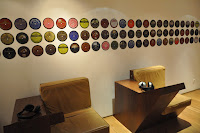I visited the Museum of Fado for the first time over the weekend and despite having found the way the overall exhibition was organised rather interesting my atttention was focused on the various fado related paintings spread around the numerous galleries.
My personal liking of fado and its lyrics didn't exactly start as a young girl but rather at a later stage of my life and particularly because of working reasons as I had to accompany a group of foreign visitors and colleagues from different aiports abroad in the 90's. The fact that they couldn't understand the lyrics of the songs being sung by random fado singers in a tavern in the heart of Alfama led me to having to translate them some of those, which I found to be profoundly deep and poetically beautiful. I soon bought the film by Carlos Saura "Fados" which highlighted quite a few of the exquisite nuances of this musical genre and I finally surrendered to its magic.

I feel particularly proud that the young generation is keen on fado and many will certainly become (some already are) the embassadors of such a musical genre in the world because that clearly means fado will live on.

The first painting I came across in the Museum was the famous 1910 oil on canvas named Fado by José Malhoa followed by other equally interesting ones by well known Portuguese painters from various epochs.

The 1913 three panel oil on canvas (two of which I photographed) named Sailor by Constantino Fernandes.
Undated charcoal on vegetal paper depicting the guitar player Carlos Paredes by Julio Pomar (left).The 1995 print on canvas titled Fado by Paula Rego (right).
The 1952 oil on canvas titled Lisbon dweller by Cândido da Costa Pinto (right).
A 1997 print on canvas titled Amalia in black by Leonel Moura (left). A 2012 oil on paper titled Fado by José Luis Tinoco (right).
A 1998 artistic mixed painting by Rui Pimentel titled Lisbon alley
Dress worn by Luz Sa da Bandeira during one of her fado performances.
(To be continued)

















No comments:
Post a Comment